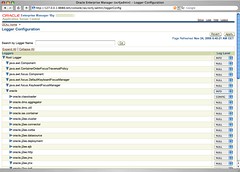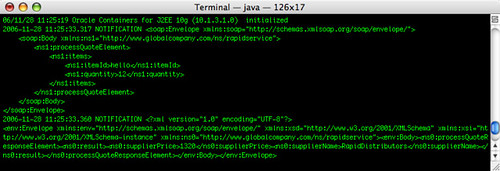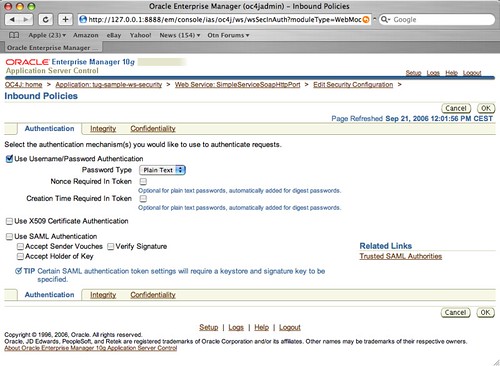Tuesday, December 26, 2006
SOAP Client: A simple Web Services testing tools for Mac
Saturday, December 23, 2006
VMWare finally on Mac (Beta)
 As Mac user I sometimes need to use Windows (too often...) or Linux computer, and for this I have been using either my PC or Parallels. Parallels is great but in my daily job my coworker are mainly using VMWare images....
As Mac user I sometimes need to use Windows (too often...) or Linux computer, and for this I have been using either my PC or Parallels. Parallels is great but in my daily job my coworker are mainly using VMWare images....
VMWare has now open the VMware Virtualization for Mac Beta Program. If you like me need virtualization jump on it and give feedback...
Friday, December 22, 2006
A nice christmas present for Groovy and Grails project
 The groovy project gets funding for its development. Big Sky is hiring Jochen
Theodorou one of the Groovy commiter. For the people that do
not know Big Sky, Big Sky is the company behind the the No
Fluff Just Stuff symposium tour. Talking about this
symposium, in 2007, Groovy and
Grails will have a dedicated track.
The groovy project gets funding for its development. Big Sky is hiring Jochen
Theodorou one of the Groovy commiter. For the people that do
not know Big Sky, Big Sky is the company behind the the No
Fluff Just Stuff symposium tour. Talking about this
symposium, in 2007, Groovy and
Grails will have a dedicated track. More about this funding:
- eWeek news article
- Jay Zimmerman (founder of Big Sky) and Jochen Theodorou's interviews/article from infoQ.
In addition to this very good news, here some other activities around Groovy and Grails:
- Releases of Groovy 1.0 and Grails 0.4
- Two books on Groovy and one on Grails.
- A dedicated Groovy and Grails website: aboutGroovy.com
- Also a dedicated Groovy and Grails conference: the Grails eXchange 2007
- And the third Groovy Developer Conference in Paris at the end of January
Wednesday, December 20, 2006
Jesus Rodriguez: Interoperability between OracleAS and between Windows Communication Foundation (WCF)
MTOM Interoperability:WS-Security Interoperability: In addition Jesus did also publish previously articles on OracleAS BPEL Process Manager and Microsoft:
- MTOM Interoperability between Oracle Application Server and Windows Communication Foundation Part1: From WCF to Oracle
- MTOM Interoperability between Oracle Application Server and Windows Communication Foundation Part2: From Oracle to WCF
Tuesday, December 5, 2006
Web Conference: Groovy & Grails UG London
 Speaking at this month's meeting will be Graeme Rocher, Grails Project Lead and CTO at Skills Matter. During his talk entitled; Grails Dynamic Tags: Making Tag Libraries Agile, Graeme will discuss Groovy Server Pages and its support for the creation of dynamic tag libraries without the need for configuration.
John Wilson, Groovy Committer, will also be presenting at this meeting. During his talk, entitled; The MetaClass: How Groovy works Under the Hood, John will shed light on the MetaClass so you can better understand its' function and see how to use it to get your Groovy programs smaller, clearer and faster.
Speaking at this month's meeting will be Graeme Rocher, Grails Project Lead and CTO at Skills Matter. During his talk entitled; Grails Dynamic Tags: Making Tag Libraries Agile, Graeme will discuss Groovy Server Pages and its support for the creation of dynamic tag libraries without the need for configuration.
John Wilson, Groovy Committer, will also be presenting at this meeting. During his talk, entitled; The MetaClass: How Groovy works Under the Hood, John will shed light on the MetaClass so you can better understand its' function and see how to use it to get your Groovy programs smaller, clearer and faster. For more information on attending this meeting or signing up for the web conference, please go to: http://skillsmatter.com/groovy-grails-ug
For more information on attending this meeting or signing up for the web conference, please go to: http://skillsmatter.com/groovy-grails-ug
Monday, December 4, 2006
Calling a Web Services Protected using HTTP Basic
((Stub)port)._setProperty(Stub.USERNAME_PROPERTY, "username");
((Stub)port)._setProperty(Stub.PASSWORD_PROPERTY, "password");
That's it...
Theses properties are shortcuts to the standard JAX-RPC properties:
javax.xml.rpc.security.auth.username
javax.xml.rpc.security.auth.password
This code is the same when you are using the Call interface.
Tuesday, November 28, 2006
OC4J: Sending system level message in the console window
By default the logger will write all the information in the default log.xml file, and for application lever logger it will go in the application.log. You may want to send the information in the console during development to debug/analyze your application. This is done using the configuration of the Handler. This information is currently not available in the Application Server Console, so I am documenting in the next steps how to send the information in the console (terminal window).
The configuration of the OracleAS Logging is saved in the $ORACLE_HOME/j2ee/home/config/j2ee-logging.xml file. In this file you can see that Oracle has defined various handlers where information can be sent:
- console-handler : Log the information in the console (the one we want to use in this sample)
- oc4j-handler : the default handler for most of the loggers, saving the information in the $ORACLE_HOME/j2ee/home/log/oc4j/log.xml using the Oracle Logger formatting
- oracle-webservices-management-auditing-handler : the handler used by the Web Services Auditing feature in the $ORACLE_HOME/j2ee/home/log/wsmgmt/auditing/log.xml
- oracle-webservices-management-logging-handler : the handler used by the Web Service Logging feature in the $ORACLE_HOME/j2ee/home/log/wsmgmt/logging/log.xml
<logger name="oracle.webservices.management.auditing" level="NOTIFICATION:1" useParentHandlers="false">
<handler name="oracle-webservices-management-auditing-handler"/>
<handler name="console-handler"/>
</logger>
You can also use this configuration with any loggers available in OC4J.
Monday, November 20, 2006
Download the The Oracle Technology Network (OTN) "Greatest Hits"
Monday, November 13, 2006
IBM article: JAX-RPC vs JAX-WS
Friday, October 13, 2006
Using HTTPS with Web Services
In this article you have
- already a Web Service deployed in OC4J that is running on the default HTTP port. The WSDL and Endpoint are available. In my sample the non secure Web Service endpoint is: http://127.0.0.1:8888/math-service/MathServiceSoapHttpPort
Add HTTPS to OC4J
Creating of the Keystore
The first thing to do to secure OC4J would be to create a new keystore that will contain the different certificates. The easiest way to do that for a Java developer is to use SUN's keytool:keytool -genkey -alias oracle-server -dname "CN=Tug Grall, OU=Blog O=Grall And Co L=Redwood Shores, S=CA, C=US" -keyalg RSA -keypass welcome -storepass welcome -keystore server.keystoreYou can copy the server.keystore into the $ORACLE_HOME/j2ee/home/config to simplify the next steps.
Configuring OC4J
OC4J stand alone is using the notion of Web-Site to expose HTTP resources (Web Applications). The default-web-site is define is he $ORACLE_HOME/j2ee/home/config/default-web-site.xml. To secure an OC4J you can follow the steps describe in the OC4J Security guide that I have summarized in the following section.What we want to achieve for the purpose of the demonstration is to have OC4J using HTTP and HTTPS, on port 8888 and 4443 for example.
1. Copy default-web-site.xml to secure-web-site.xml
2. Edit the secure-web-site.xml:
2.1. Add the ssl-config element and point this to the new created keystore.
The file looks like:
<web-site xmlns:xsi="http://www.w3.org/2001/XMLSchema-instance"
xsi:noNamespaceSchemaLocation="http://xmlns.oracle.com/oracleas/schema/web-site-10_0.xsd"
port="4443"
secure="true"
display-name="OC4J 10g (10.1.3) Default Web Site"
schema-major-version="10"
schema-minor-version="0" >
...
<ssl-config keystore="server.keystore" keystore-password="welcome" />
...
</web-site>
3. Import the new Web site in your OC4J instance by editing the $ORACLE_HOME/j2ee/home/server.xml file. You need to add or replace the web-site tag. In my case I want to add the secure web site to my instance so the configuration looks like:
...
<web-site default="true" path="./default-web-site.xml" />
<web-site path="./secure-web-site.xml" />
...
Since we have copied the file from the default-web-site, all applications are available using HTTP and HTTPS
Start OC4J and test the HTTPS port
Start OC4J using the standard Java command or shell script, I am adding the Java Network debug flag that would help you to see what is happening at the SSL level.java -Djavax.net.debug=ssl -jar oc4j.jar
You should be able to access the service WSDL using the HTTPS port for example in my case:
- https://127.0.0.1:4443/math-service/MathServiceSoapHttpPort?WSDL
Consuming the Service using HTTPS
Generate and configure a client Keystore
Event if this is possible to use the same keystore for the server and the client, I will guide you in the steps to create a client certificate and import the certificate from the existing -server- one. Here the command to create a new keystore:keytool -genkey -alias oracle-client -dname "CN=John Doe, OU=Blog O=MyDummyClient, S=CA, C=US" -keyalg RSA -keypass welcomeClient -storepass welcomeClient -keystore client.keystore
The next step is to export the certificate from the server keystore to be able to import it in the client:
keytool -keystore server.keystore -export -alias oracle-server -file server.cer
You can now import the cerificate in the client keystore:
keytool -keystore client.keystore -import -file server.cer
Generate the proxy
You have now the client certificate so you can use the Oracle Web
Service Assembler to generate the proxy. The only specific thing you
have to do is to specify which key store to use when running the tool.
The command to use when generating the proxy is:java -Djavax.net.ssl.trustStore=/Users/tgrall/ssl/client.keystore
-Djavax.net.ssl.keyStore=/Users/tgrall/ssl/client.keystore
-Djavax.net.ssl.trustStorePassword=welcomeClient
-Djavax.net.ssl.keyStorePassword=welcomeClient
-jar $ORACLE_HOME/webservices/lib/wsa.jar
-genProxy
-wsdl https://127.0.0.1:4443/math-service/MathServiceSoapHttpPort?WSDL
Calling the Service using secure endpoint
Configure the Java Environment to use the client store is made using the following System properties:- javax.net.ssl.trustStore
- javax.net.ssl.keyStore
- javax.net.ssl.trustStorePassword
- javax.net.ssl.keyStorePassword
This could be done using different approach, property file, -D command line parameter or programmatically. To simply the example I am using the programmatic approach, the following code is part of the main method of the Client class:
...
System.setProperty("javax.net.ssl.trustStore", "/Users/tgrall/ssl/client.keystore");
System.setProperty("javax.net.ssl.keyStore", "/Users/tgrall/ssl/client.keystore");
System.setProperty("javax.net.ssl.trustStorePassword", "welcomeClient");
System.setProperty("javax.net.ssl.keyStorePassword", "welcomeClient");
...
// Adding Debug information
System.setProperty("javax.net.debug", "ssl");
...
It is possible to change the Endpoint dynamically in the Proxy using the setEndpoint method.
...
democlient.proxy.MathServiceSoapHttpPortClient myPort = new democlient.proxy.MathServiceSoapHttpPortClient();
...
String ep = "https://127.0.0.1:4443/math-service/MathServiceSoapHttpPort";
myPort.setEndpoint(ep);
System.out.println("Result of the operation is "+ myPort.add(2,2));
...
You should now be able to run the client and call the service using HTTPS. This would look like:
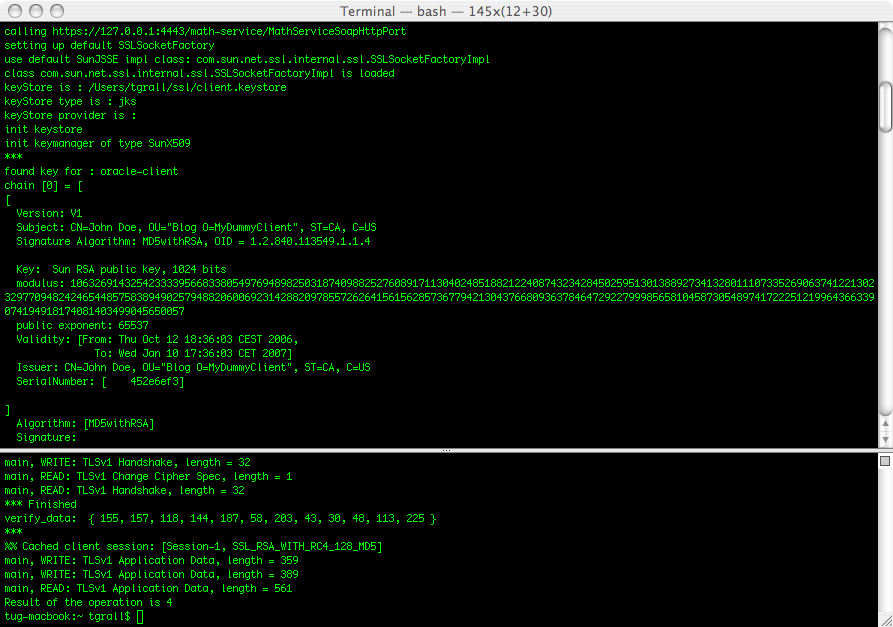
JDeveloper: What are my System Properties?
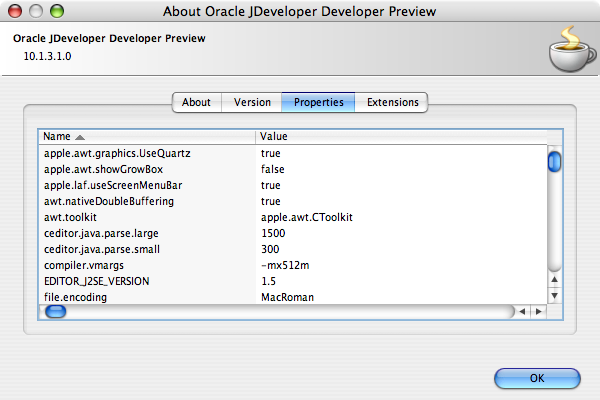
Thanks to Gerard for the tip....
Thursday, October 12, 2006
Come to Oracle Open World and watch Mr Spring and Mr Apache speak
Oracle Open World is getting very close... And I am very excited to go to lot of sessions, two of them looks very interesting in the Oracle Develop track:
- Rod Johnson - Spring Update: What's New and Cool in Spring 2.0 (Monday 10/23/2006, 12:45 PM - 1:45 PM in the Hilton Hotel Grand Ballroom A)
- Brian Behlendorf - Bringing Open Source Software Development Practices and Principles Into Your Company (Tuesday 10/24/2006, 1:15 PM - 2:15 PM in the Hilton Hotel Grand Ballroom A)
This is quite exciting to have Open Source gurus coming to present to the Oracle conference, and explain how to use the new Spring in their projects or leverage Open Source practices to improve development in house... Take a look to the full program of Oracle Develop.
Start to use the Oracle OpenWorld Schedule Builder to organize your week in SF, if you have not registered yet for OOW click here.
Wednesday, October 4, 2006
Configuring the SOAP Address in OracleAS Web Services
If you take a look to the WSDL, the SOAP address of the SOAP HTTP Port is dynamically generated based on the calling URL, for example if you have a service running on your machine:
http://127.0.0.1:8888/math-service/MathServiceSoapHttpPort?WSDL
will generate the following information in the WSDL
<service name="MathService">
<port name="MathServiceSoapHttpPort" binding="tns:MathServiceSoapHttp">
<soap:address location="http://127.0.0.1:8888/math-service/MathServiceSoapHttpPort"/>
</port>
</service>
But if you are using another URL, for example the name of the computer:
http://tgrall-computer:8888/math-service/MathServiceSoapHttpPort?WSDL
will generate:
<service name="MathService">
<port name="MathServiceSoapHttpPort" binding="tns:MathServiceSoapHttp">
<soap:address location="http://tgrall-computer:8888/math-service/MathServiceSoapHttpPort"/>
</port>
</service>
<oracle-webservices xmlns:xsi="http://www.w3.org/2001/XMLSchema-instance" .... >
<web-site host="www.grallandco.com" port="80" />
<webservice-description name="MathService">
...
...
</webservice-description>
</oracle-webservices>...
This element and all other Oracle Web Services configuration elements are documented in the Oracle Web Service Developer Guide.
Thursday, September 21, 2006
Accessing User Principal in a Web Service
I have a service service, and I need to access some user information in its implementation class ( org.tug.ws.sample.SimpleServiceImpl ). This service is secure with WS-Security, with for example simple authentication, the following screenshot, is the configuration of inbound security in OracleAS 10gR3:
So the service is secured, here the code that you have to add in your service implementation (or handlers) to access the Principal object.
- Implement javax.xml.rpc.server.ServiceLifecycle
- Implement the init(Object context) method to access
the ServletEndpointContext,
that you can for example put as a local member of your implementation
class.
public void init(Object context) {
_servleContext = (ServletEndpointContext)context;
}
-
Then you can access the principal object using the getUserPrincipal() method:
...
if (_servleContext.getUserPrincipal() != null ) {
Principal userPrincipal = _servleContext.getUserPrincipal();
...
}
...
Update on Wednesday october 4th: Frank Nimphius, has use this entry to create a more detail article about End to End Security with Web Services Security.
Tuesday, September 19, 2006
Choose a scripting language? Groovy or JRuby?
Last week I discussed dynamic languages with some consultants. This discussion was done in the context of integration of scripting technologies into Java EE environment. So the integration to the VM is important, I also think that the learning curve is a thing to consider.
It is true that, like any developer Iike to learn things everyday, this is why I have done some development with PHP, with Ruby On Rails, and obviously with Groovy, Javascript and many other dynamic languages. The discussion moved quickly to an argument about which language is the best... Hard to say, but I would expect that to be more productive in enterprise it is better to use a "Java Like" syntax that allows you to leverage the power of scripts. Based on this comment it is for me a no brainer to say that Groovy is more interesting to a core Java developer than JRuby (or other Jython, Jacl, ...). I do not even want to go in the details about VM integration, performances and so on... So in this context, A. Sundararajan has posted a very interesting comparison of Java, Groovy and JRuby syntaxes.
Thursday, May 11, 2006
More Groovy at Javaone !
 If
like me you like scripting technologies and in particular Groovy and
Grails, JavaOne 2006 will be a very good moment to learn more about it.
If
like me you like scripting technologies and in particular Groovy and
Grails, JavaOne 2006 will be a very good moment to learn more about it.Beside the official sessions listed below, I would like to inform you of various events interesting for the Groovy community:
- Informal “Groovy Community Meeting”, Thursday night 5pm around the Oracle Demobooth where Guillaume, Graeme and Dierk will give you an opportunity to learn more about these projects
- Groovy presentations at the Oracle Booth in the pavillion
- Intro do Groovy by Harshad Oak : Wednesday 17th at 3pm
- Groovy In Action by Guillaume Laforge: Tuesday 16 at 5pm
- Grails by Graeme Rocher: Thursday 18th
at 3pm
The official sessions about Groovy and Grails are
| BOF-0554 | Dynamic Scripting Languages BOF |
Tuesday 05/16/2006 10:30 PM - 11:20 PM |
Moscone Center Hall E 133 |
| BOF-2521 | Rapid Web Application Development With Grails |
Thursday 05/18/2006 08:30 PM - 09:20 PM |
Moscone Center Esplanade 307-310 |
| TS-1246 | Simplify Enterprise Development With Scripting |
Thursday 05/18/2006 11:00 AM - 12:00 PM |
Moscone Center Hall E 134 |
| TS-3273 | Groovy = Java™ Technology+ Ruby + Python for the JVM™ |
Wednesday 05/17/2006 02:45 PM - 03:45 PM |
Moscone Center Gateway 104 |
| TS-3714 | Flash-Gridding with Java™ Technology: Using Project GlassfishSM, Jini™/JavaSpaces™, and Groovy as an Environment for an Open Source, Self-Assembling Supercomputer |
Thursday 05/18/2006 02:45 PM - 03:45 PM |
Moscone Center Gateway 104 |
| TS-5386 | Groovy Goes RFID with Smart Sensors for Real-World Control |
Tuesday 05/16/2006 05:45 PM - 06:45 PM |
Moscone Center Gateway 104 |
Wednesday, May 3, 2006
Grails on Oracle (OracleAS and OracleXE)
What is Groovy? What is Grails?
Groovy is a dynamic language that leverage features from other languages such as Ruby, Jython, and Smalltalk. Groovy is running at the top of a Java VM and makes available any existing Java objects (so all the API) to Groovy. Groovy is currently under standardization with the JSR-241. You can learn more about Groovy on the Groovy site and is project leader's (Guillaume Laforge) blog. GRAILS is to Groovy what Ruby On Rails is to Ruby. Originally named "Groovy On Rails", this name has been dropped in favor of Grails to avoid confusion/competition. Like Ruby on Rails, Grails is designed to create CRUD (Create Read Update Delete) Web applications. You can learn more about Grail on the Grails site and is project leader's (Graeme Rocher) blog. Let's now dive in the sample application, for this, as stated earlier I am using the sample application described in the OTN articles.Example: The product Catalog
Step 1: Set up the Oracle database
If you have not set up the schema and table from the article you just need to create the following objects:Based on the OTN article I have created this table in the ruby schema.CREATE TABLE comics ( id NUMBER(10) NOT NULL, title VARCHAR2(60), issue NUMBER(4), publisher VARCHAR2(60), PRIMARY KEY (id) ); CREATE SEQUENCE comics_seq;
Step 2: Install Grails
Grails installation is straight forward and explained in the Installation guide, basically:- Download the binaries (I used Grails 0.2)
- Setup the different environment variable (GRAILS_HOME, JAVA_HOME, PATH), I used Java 5.
Step 3: create the Web Application
Now we have installed the product, the next step is to create the application itself. Create the application The create-app command is creating the full project, with the template with placeholder for the different components of your application such as configuration, MVC, and library and much more. To do it enter the following command, in your command line interface:> grails create-app .... ..... create-app: [input] Enter application name: comics_catalog .....As you will see, Grails uses Ant intensively, the create-app command will ask you for an application name, enter for example comics_catalog. The created application contains now a list of directory allowing developer to start to build the application using Groovy, Grails and any Web components. Add the Business Logic and Model: Domain Classes One of the biggest differences between Grails and RoR, is the fact that the main components of your application development is not the Table like you have in RubyOnRails but the "Domain Class". The domain class are the core of the business application, they contains the state and the behavior of your application. So the next step is to create a Domain Class for the Comics, to do that you just need to go in the home directory of your project, eg cd comics_catalog and run the create-domain-class.
> cd comics_catalog > grails create-domain-class .... create-domain-class: [input] Enter domain class name: comics ....When the command ask you to enter the class name, enter comics. Grails, will not use the same naming convention that RoR has, so you need to use the same name for the class and the table you want to map your object on. The persistence layer is made using GROM (Grails Object Relational Mapping) that leverage hibernate. Note: In our case what we are doing is to leverage an existing database object and create the domain class at the top of it. Usually, Grails uses a different approach where everything is driven by the application, so you create the domain class first and then Grails will create the different database objects. The Comics class does not have any information related to the mapping itself, so you have to create the different attributes in the domain class. This is where you you start to use Groovy, the domain class is located in the following location:
- ./comics_catalog/grails-app/domain/Comics.groovy
class Comics { @Property Long id @Property Long version // new properties for the Comics class @Property String title @Property Long issue @Property String publisher String toString() { "${this.class.name} : $id" } }We are all set, we are ready to run the magic command that will create the different screens and flow. Create the different screens from the domain class You can now run the generate-all command to create all the different screens.
> grails generate-all .... input-domain-class: [input] Enter domain class name: comics ....This command creates the different Views and Controllers, you can take a look to the directories:
- ./comics_catalog/grails-app/controllers
- ./comics_catalog/grails-app/views
- ./comics_catalog/grails-app/conf/ApplicationDataSource.groovy
class ApplicationDataSource { @Property boolean pooled = true @Property String dbCreate = "update" // one of 'create', 'create-drop','update' @Property String url = "jdbc:oracle:thin:@localhost:1521:XE" @Property String driverClassName = "oracle.jdbc.OracleDriver" @Property String username = "ruby" @Property String password = "ruby" }Nothing special concerning the properties such as URL, DriverClassName, username and password. The one that is interesting is the dbCreate, that allows you to configure the behavior on the schema to create or not objects.In our sample the table exists, so we want to reuse the object, but we want to be sure that we have all the mandatory objects, columns too, so I selected update. The next thing to do is to add the Oracle JDBC driver to the application, to make it available. To make it available you just need to copy the JDBC driver into the lib directory of your application. In my case I am using Oracle XE so I copy the file from the following location:
- ORACLE_XE_HOME/app/oracle/product/10.2.0/server/jdbc/lib/ojdbc14.jar to
- ./comics_catalog/lib/
Step 4: Run the application
Grails provide a way to run the application in stand alone mode, the command is run-app. This command starts an Web container (based on Jetty) with the application deployed.> grails run-appNote: Jetty will start on port 8080, in order to start in on a different port like e.g. 9090 use: grails -Dserver.port=9090 run-app You can now access the application using the following URL:
http://localhost:8080/comics_catalog/comics/Your browser should show the list of comics from the Comics table.
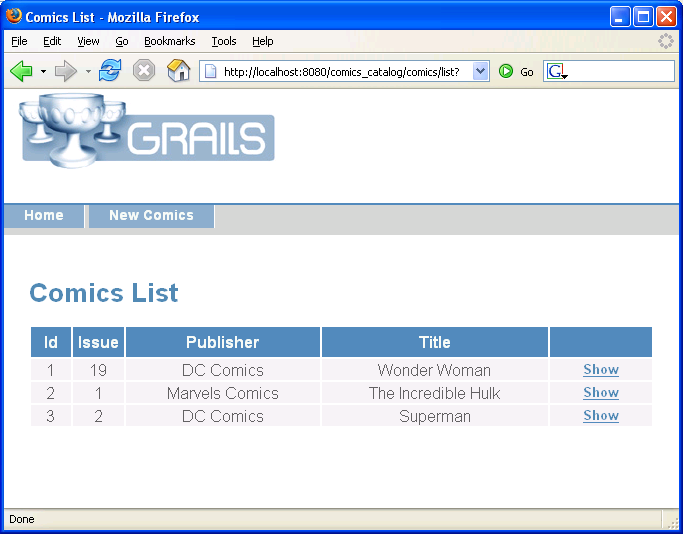
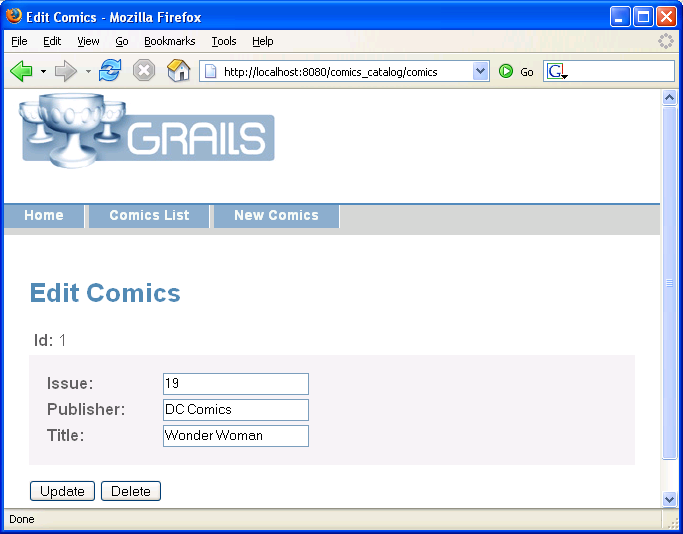
Step 5: Deploy the application
Grails provides a command to package the application as a WAR ready to be deployed, so in the root directory of your project you can run the following command:> grails warWhen you run this command you end with a WAR with the name of your application located in the root of your project, in our case: comics_catalog.war If you take a look to this WAR you'll see that it is quite big ~10Mb, this is because all the libraries are included in the Lib directory of the web application. You can see the exact structure of the WAR in the ./tmp (./comics_catalog/tmp/war) directory of the application. You can deploy the application as it is to Oracle Application Server 10g, but to avoid the issue with the class loader you should configure the Web application to load the local classes first. It can be done during deployment with the class loader configuration screen:
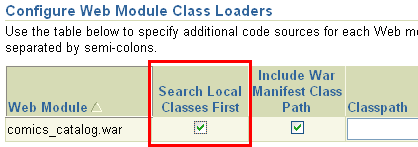
http://localhost:8888/comics_catalog/comics/listYou can now administer and monitor the application like any other J2EE application deployed in OracleAS 10g. Better Deployment Options
- I personally do not like the idea of shipping all the Jar files in the WAR file, so instead you can use the OracleAS Shared Libraries to create a Grails library by uploading and configuring all the Jars. And package the War without all these libraries.
- Also you should be able to configure Hibernate/Spring to use a standard define Data source and use the JNDI name to lookup the connections.
Conclusion
GRAILS like Ruby On Rails are really interesting frameworks allowing developers to create quickly Web application that access relational database and especially the Oracle Database. Grails is quite new (release 0.2), but the documentation is really nice and complete. I will encourage all developers that are interested by such framework to use it and provide feedback to the development team. I will try provide other post about deployment of Grails on OracleAS, but also related to other interesting features of this framework, for example Ajax support, Validations etc etc.Resources
Sunday, April 23, 2006
Oracle BPEL: Debugging "internal" SOAP Messages
- Oracle BPEL Process Manager developer install running in an OC4J 10g Stand Alone (10.1.2.0.2)
- obtunnel, that is a package version of Axis TCP Monitor located in <BPEL_HOME>\bin\obtunnel.bat
- LoanFlow demo that you can install in 2 steps:
- In a shell, go to <BPEL_HOME>\samples\demos\LoanDemo
- Run the following command to deploy the LoadFlow BPEL and associated Web Services: > ..\..\..\bin\obant
Starting the Oralce BPEL Tunneling tool:
- Just run the command <BPEL_HOME>\bin\obtunnel.bat You will see the following application:
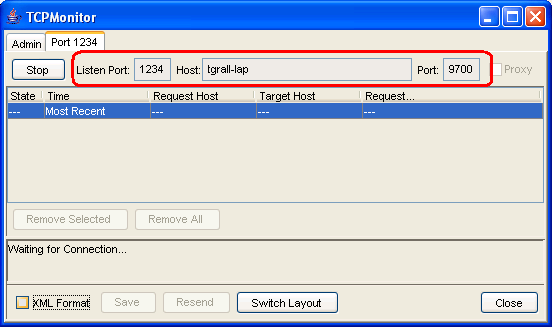
Changing the Port of OC4J and the TCP Monitor
I. Change the HTTP port of OC4J used by BPEL- Open <BPEL_HOME>\system\appserver\oc4j\j2ee\home\config\http-web-site.xml
- Edit the port attribute of the root element web-site to enter a different value eg: <web-site port="9701"...
- Stop your BPEL Process Manager
- In the TCPMonitor sceen click on the Admin Tab
- Enter 9700 for the "Listen Port #" field (since we want to be sure the partnerlinks are called correctly)
- Enter 9701 (or the value you entered for the HTTP port) for "Target Port #".
- Click Add
- Click on the new tab "Port 9700". If you have an error message like "java.net.BindException: Address Already in use: JVM_Bind" this is simply because your BPEL process manager is not stopped. In this case stop the BPEL server, and start the TCPMonitor by clicking the Start button.
- http://localhost:9701/BPELConsole
Turning Off the SOAP Shortcut
- In the BPEL console, click on the "Manage BPEL Domain" link (top right)
- You arrive in the configuration tab, look for the optSoapShortcut property and set it to false.
- Click Apply
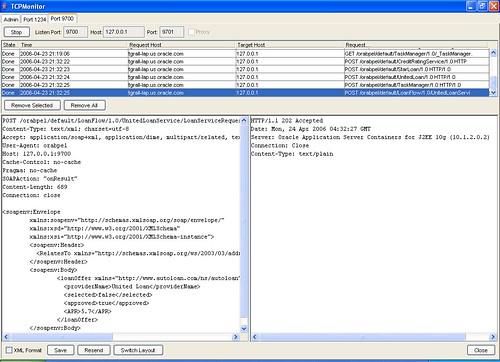 Click to Enlarge
Click to Enlarge
Wednesday, April 12, 2006
Grails on Oracle (OracleAS and OracleXE)
If you are not familiar at all with Ruby On Rails, it is important to notice that it has nothing to do with Java, J2EE. It is a Ruby based framework. So yes Ruby On Rails is really interesting, powerful and so on... but for me as a Java developer I would like to do the same using Java (or equivalent) leveraging the investment that I have done in J2EE; also important I want to be able to deploy and manage applications that are developed this way using my tools such as Oracle Enterprise Manager Application Server Control.
The paradigm "coding by convention" that is the driver of Ruby on Rails has been leveraged to developed a new framework: GRAILS. Grails uses Groovy as the underlying language, so it runs on a JVM and can leverage any existing Java API.
If you are a Java developer you will find very interesting to use this framework to accelerate the development of Web applications. If you are not yet a Java developer but need to develop Web application faster, and deploy the to your J2EE application server, Grails is also a very good tools.
Since I have started with Richard's article I will use the same application/database schema to develop my first GRAILS application, and also use the same structure in my article...(is it what we call lazy loading?)
What is Groovy? What is Grails?
Groovy is a dynamic language that leverage features from other languages such as Ruby, Jython, and Smalltalk. Groovy is running at the top of a Java VM and makes available any existing Java objects (so all the API) to Groovy. Groovy is currently under standardization with the JSR-241. You can learn more about Groovy on the Groovy site and is project leader's (Guillaume Laforge) blog.GRAILS is to Groovy what Ruby On Rails is to Ruby. Originally named "Groovy On Rails", this name has been dropped in favor of Grails to avoid confusion/competition. Like Ruby on Rails, Grails is designed to create CRUD (Create Read Update Delete) Web applications. You can learn more about Grail on the Grails site and is project leader's (Graeme Rocher) blog.
Let's now dive in the sample application, for this, as stated earlier I am using the sample application described in the OTN articles.
Example: The product Catalog
Step 1: Set up the Oracle database
If you have not set up the schema and table from the article you just need to create the following objects:
Based on the OTN article I have created this table in the ruby schema.CREATE TABLE comics (
id NUMBER(10) NOT NULL,
title VARCHAR2(60),
issue NUMBER(4),
publisher VARCHAR2(60),
PRIMARY KEY (id)
);
CREATE SEQUENCE comics_seq;
Step 2: Install Grails
Grails installation is straight forward and explained in the Installation guide, basically:- Download the binaries (I used Grails 0.2)
- Setup the different environment variable (GRAILS_HOME, JAVA_HOME, PATH), I used Java 5.
Step 3: create the Web Application
Now we have installed the product, the next step is to create the application itself.Create the application
The create-app command is creating the full project, with the template with placeholder for the different components of your application such as configuration, MVC, and library and much more. To do it enter the following command, in your command line interface:
> grails create-appAs you will see, Grails uses Ant intensively, the create-app command will ask you for an application name, enter for example comics_catalog.
....
.....
create-app:
[input] Enter application name:
comics_catalog
.....
The created application contains now a list of directory allowing developer to start to build the application using Groovy, Grails and any Web components.
Add the Business Logic and Model: Domain Classes
One of the biggest differences between Grails and RoR, is the fact that the main components of your application development is not the Table like you have in RubyOnRails but the "Domain Class". The domain class are the core of the business application, they contains the state and the behavior of your application.
So the next step is to create a Domain Class for the Comics, to do that you just need to go in the home directory of your project, eg cd comics_catalog and run the create-domain-class.
> cd comics_catalogWhen the command ask you to enter the class name, enter comics. Grails, will not use the same naming convention that RoR has, so you need to use the same name for the class and the table you want to map your object on. The persistence layer is made using GROM (Grails Object Relational Mapping) that leverage hibernate.
> grails create-domain-class
....
create-domain-class:
[input] Enter domain class name:
comics
....
Note: In our case what we are doing is to leverage an existing database object and create the domain class at the top of it. Usually, Grails uses a different approach where everything is driven by the application, so you create the domain class first and then Grails will create the different database objects.
The Comics class does not have any information related to the mapping itself, so you have to create the different attributes in the domain class. This is where you you start to use Groovy, the domain class is located in the following location:
- ./comics_catalog/grails-app/domain/Comics.groovy
class Comics {
@Property Long id
@Property Long version
// new properties for the Comics class
@Property String title
@Property Long issue
@Property String publisher
String toString() { "${this.class.name} : $id" }
}
We are all set, we are ready to run the magic command that will create the different screens and flow.
Create the different screens from the domain class
You can now run the generate-all command to create all the different screens.
> grails generate-allThis command creates the different Views and Controllers, you can take a look to the directories:
....
input-domain-class:
[input] Enter domain class name:
comics
....
- ./comics_catalog/grails-app/controllers
- ./comics_catalog/grails-app/views
Configure the database access
What we have to do is now to configure the application to use the Oracle database and schema.
Grails uses a configuration file for data source:
- ./comics_catalog/grails-app/conf/ApplicationDataSource.groovy
class ApplicationDataSource {Nothing special concerning the properties such as URL, DriverClassName, username and password.
@Property boolean pooled = true
@Property String dbCreate = "update" // one of 'create', 'create-drop','update'
@Property String url = "jdbc:oracle:thin:@localhost:1521:XE"
@Property String driverClassName = "oracle.jdbc.OracleDriver"
@Property String username = "ruby"
@Property String password = "ruby"
}
The one that is interesting is the dbCreate, that allows you to configure the behavior on the schema to create or not objects.In our sample the table exists, so we want to reuse the object, but we want to be sure that we have all the mandatory objects, columns too, so I selected update.
The next thing to do is to add the Oracle JDBC driver to the application, to make it available. To make it available you just need to copy the JDBC driver into the lib directory of your application. In my case I am using Oracle XE so I copy the file from the following location:
- ORACLE_XE_HOME/app/oracle/product/10.2.0/server/jdbc/lib/ojdbc14.jar
to - ./comics_catalog/lib/
Step 4: Run the application
Grails provide a way to run the application in stand alone mode, the command is run-app. This command starts an Web container (based on Jetty) with the application deployed.> grails run-appNote: Jetty will start on port 8080, in order to start in on a different port like e.g. 9090 use:
grails -Dserver.port=9090 run-app
You can now access the application using the following URL:
http://localhost:8080/comics_catalog/comics/Your browser should show the list of comics from the Comics table.

You can create a new entry by clicking on the "New Comics" tab, and view/edit/delete existing record by clicking on the "Show" link.

Step 5: Deploy the application
Grails provides a command to package the application as a WAR ready to be deployed, so in the root directory of your project you can run the following command:> grails warWhen you run this command you end with a WAR with the name of your application located in the root of your project, in our case: comics_catalog.war
If you take a look to this WAR you'll see that it is quite big ~10Mb, this is because all the libraries are included in the Lib directory of the web application. You can see the exact structure of the WAR in the ./tmp (./comics_catalog/tmp/war) directory of the application.
You can deploy the application as it is to Oracle Application Server 10g, but to avoid the issue with the class loader you should configure the Web application to load the local classes first. It can be done during deployment with the class loader configuration screen:

When the deployment is done you can access the application using the OracleAS host and port, something like:
http://localhost:8888/comics_catalog/comics/list
You can now administer and monitor the application like any other J2EE application deployed in OracleAS 10g.
Better Deployment Options
- I personally do not like the idea of shipping all the Jar files in the WAR file, so instead you can use the OracleAS Shared Libraries to create a Grails library by uploading and configuring all the Jars. And package the War without all these libraries.
- Also you should be able to configure Hibernate/Spring to
use a standard define Data source and use the JNDI name to lookup the
connections.
Conclusion
GRAILS like Ruby On Rails are really interesting frameworks allowing developers to create quickly Web application that access relational database and especially the Oracle Database.Grails is quite new (release 0.2), but the documentation is really nice and complete. I will encourage all developers that are interested by such framework to use it and provide feedback to the development team.
I will try provide other post about deployment of Grails on OracleAS, but also related to other interesting features of this framework, for example Ajax support, Validations etc etc.
Resources
Thursday, March 23, 2006
Google Data APIs
 Google has published a new set of API (and format) to update and access data. It looks really interesing. These services are published using the REST paradigm and XML.
Based on this protocol Google is now exposing its Calendar. I am currently playing around with it, really fun. A good opportunity for portlets and widgets developments...
Note for Oracle JDeveloper 10g (10.1.3) users: I have define the GData and Calendar API as new library inside Oracle JDeveloper. But I had some issue compiling when I start to use any of the class coming from these library with the default configuration on Windows XP. I just switch from Oracle JVM to the standard JDK compiler in my project to avoid this "Error: Internal compilation error, terminated with a fatal exception". To do this it is quite simple. Double click on your project, choose compiler in the left tree, and check the "Use Javac" option to force JDeveloper to use the standard javac command. (I will have to find where this issue come from...)
Google has published a new set of API (and format) to update and access data. It looks really interesing. These services are published using the REST paradigm and XML.
Based on this protocol Google is now exposing its Calendar. I am currently playing around with it, really fun. A good opportunity for portlets and widgets developments...
Note for Oracle JDeveloper 10g (10.1.3) users: I have define the GData and Calendar API as new library inside Oracle JDeveloper. But I had some issue compiling when I start to use any of the class coming from these library with the default configuration on Windows XP. I just switch from Oracle JVM to the standard JDK compiler in my project to avoid this "Error: Internal compilation error, terminated with a fatal exception". To do this it is quite simple. Double click on your project, choose compiler in the left tree, and check the "Use Javac" option to force JDeveloper to use the standard javac command. (I will have to find where this issue come from...)
Monday, March 13, 2006
Oracle Industrial Telnet Server (ITS): The OracleAS Hidden Treasure..
When I was working in Oracle Consulting I was surprised to see how many customers are using character mode applications, base on Oracle Forms. Lot of applications in wharehouses, harbour, ... are using telnet terminal, usually remote/mobile using RF networks.
Moving to Java on the server was very hard for them because of the lack of support for easy character mode development based solutions.
OracleAS 10g/ADFprovides such support with the Industrial Telnet Server (ITS). ITS is the telnet server running in a J2EE container as a J2CA adaptor, and uses JavaServer Faces to render the user interface. The advantage of using JSF for the UI, it allows developer to leverage automatically different renderers (HTML, Mobile and telnet) without changing the application.
Here an example of the different renderer provided by Oracle ADF Faces (Instant Messaging, PDA, HTML and Telnet)
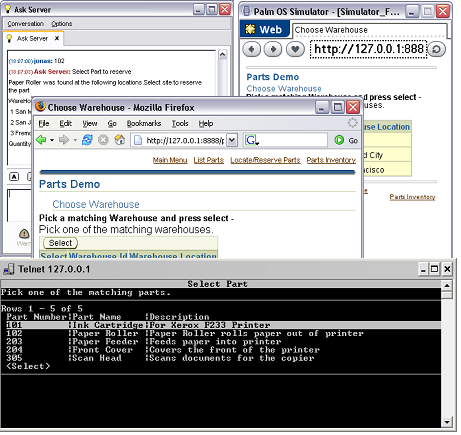
If you are looking for more information around Oracle ITS:
Thursday, March 2, 2006
Oracle Fusion Middleware and Microsoft Interoperability - Developer's Guide
Download the Beta version of the Oracle Application Server Developer's Guide for Microsoft Office Interoperability along with sample code (and other technical resources) from this new OTN page.
- Windows Platform: Fusion Middleware is concurrently tested and delivered on Windows.
- .NET/Windows Server System Integration: Fusion Middleware offers broad integration with Microsoft .NET and Windows Server System at multiple levels.
- Office Interoperability: Fusion Middleware enables use of Office as the front-end for enterprise applications, as well as many ways to interact with enterprise information that can be read, parsed, and generated in Office-formatted documents.
Friday, February 10, 2006
SourceLabs SASH certified on Oracle Fusion Middleware
SASH is a distribution from SourceLabs that: 1. Reconciles library versions and dependencies across the entire stack. 2. Includes dependability fixes for the baseline open source projects 3. Is rigorously tested according to the CERT7 method. 4. Is commercially supported.
Friday, January 27, 2006
Is OracleAS Portal used on the Internet????
 Just use google with a string used byOracleAS Portal URLs...
Just use google with a string used byOracleAS Portal URLs...
A little tip, but you will see that people are very creative with Oracle Portal 10g!

